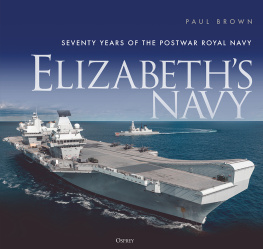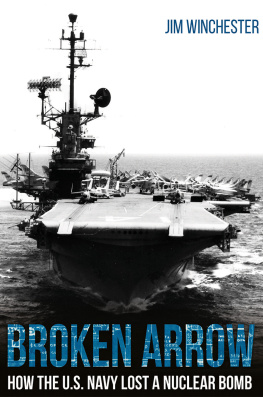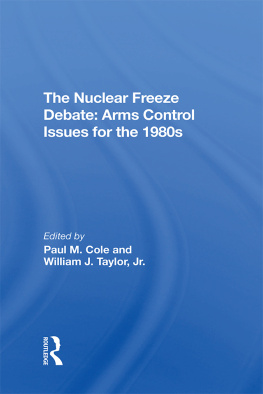THE NAVY OF
THE NUCLEAR
AGE
19472007
THE U.S. NAVY WARSHIP SERIES
The Sailing Navy, 17751854
Civil War Navies, 18551883
The New Navy, 18831922
The Navy of World War II, 19221947
The Navy of the Nuclear Age, 19472007
| First published 2009 | Simultaneously published in the UK |
| by Routledge | by Routledge |
| 270 Madison Avenue | 2 Park Square |
| New York, NY 10016 | Milton Park, Abingdon |
| Oxon OX14 4RN |
Routledge is an imprint of the Taylor & Francis Group, an informa business
2009 Paul H. Silverstone
Typeset in New Baskerville by
RefineCatch Limited, Bungay, Suffolk
Printed and bound in the United States of America on acid-free paper by
Edwards Brothers, Inc.
ISBN10: 0415978998 (hbk)
ISBN10: 020387773X (ebk)
ISBN13: 9780415978996 (hbk)
ISBN13: 9780203877739 (ebk)
All rights reserved. No part of this book may be reprinted or reproduced or utilized in any form or by any electronic, mechanical or other means, now known or hereafter invented, including photocopying and recording, or in any information storage or retrieval system, without permission in writing from the publishers.
Trademark Notice : Product or corporate names may be trademarks or registered trademarks, and are used only for identification and explanation without intent to infringe.
Library of Congress Cataloging-in-Publication Data
Silverstone, Paul H.
The Navy of the Nuclear Age, 19472007 / Paul H. Silverstone.
p. cm.(U.S. Navy warship series)
Includes bibliographical references and index.
ISBN13: 9780415978996 (hardback : alk. paper)
ISBN10: 0415978998 (hardback : alk. paper) 1. WarshipsUnited StatesHistory20th century. 2. Warships
United StatesHistory21st century. 3. United States. NavyLists of vessels. I. Title.
VA61.S546 2008
359.83097309045dc222008015307
INTRODUCTION
The sixty years after World War II were a period of world peace punctuated by a series of brutal local wars. The United States Navy was aggressively active throughout the period. In between the routine peacetime cruises and training, wars in Korea, Vietnam, and the Middle East occurred, and during most of the period the cold war with the Soviet Union was omnipresent.
After 1945 the United States demobilized most of the huge armed forces built up for combat operations. For the Navy this meant decommissioning a large percentage of its ships, many finding their way laid up into reserve fleets, while the older and acquired ships were taken off the Navy List.
With the outbreak of war in Korea in 1950, many of the laid-up ships were brought back into service. The war lasted about three years; the Navy actively supporting the ground troops with air operations and coastal bombardments. The Navy was not unscathed, suffering casualties of 505 killed, 1,576 wounded, and 286 prisoners-of-war. Seven Medals of Honor were awarded to Navy personnel, five posthumously. Several ships were sunk and more were damaged.
The tension between the Soviet Union and its allied countries resulted in a competition for superiority at sea. In 1949, the North Atlantic Treaty Organization (NATO) was established to counter Soviet threats. At sea, trouble points appeared in the Mediterranean, Arctic, and the waters off China. The Soviet Union built a large fleet of both submarines and surface warships, which soon appeared in all parts of the world. American and Soviet Navies played a cat-and-mouse game in the North Atlantic between their submarines and our anti-submarine forces. The climax occurred with a crisis in Cuba when Soviet missiles were positioned in that country and American forces challenged the Soviets. Through diplomacy a dangerous situation was defused.
In the Far East, the cold war became hot as military operations expanded in Vietnam. After the truce settlement between north and south in 1954, guerrillas from the north threatened the stability of the government in South Vietnam. Gradually, the United States became involved in ground operations. The falsely-reported Gulf of Tonkin incident in 1962 led to the introduction of large American military forces into what was essentially a civil war. As the enemy, North Vietnam and the Viet Cong, had no navy to fight, the U.S. Navy was involved in carrier operations, coastal bombardments, and riverine operations. Despite the Navys vital but peripheral role in the war, casualties amounted to 1,631 killed, 4,178 wounded, and 401 missing, plus about 150 taken as POWs. Navy personnel were awarded eleven Medals of Honor, five posthumously. The tragic outcome after ten long years of fighting led to a rethinking of American military strategy.
After Vietnam, incidents at sea involving American sea power continued to occur. Both sides sent out intelligence collectors to learn about the opposing fleets. On many occasions Soviet vessels intruded into American fleet operations, leading in a few instances to actual physical contact between ships at sea. American submarines carried out highly secret operations in or near to Soviet harbors.
In the Middle East, there was continuous tension among the various parties, alternately hot or cold. The U.S. Navy was a continuing presence in the Mediterranean and Indian Oceans. American forces became involved to safeguard American citizens when fighting broke out in Lebanon, Israel, Iran and Iraq. In 1991 after Iraq invaded Kuwait the United States led a multinational group which forced Iraq forces to withdraw and then invaded Iraq itself. The situation in the Persian Gulf smoldered on for a decade.
After the terrorist attacks on New York and Washington in September 2001, the American government took an aggressive stance first in Afghanistan, and then culminating in the decision to invade Iraq and depose the dictator Saddam Hussein. This in turn led to a long drawn-out war in the area. Navy casualties (to February 2008) total 92 killed and 600 wounded.
During these turbulent years, many drastic changes took place in the Navy. Unparalleled technological advances occurred in ships and weapons resulting in major changes in overall strategy and tactics. Faced with major innovations such as nuclear weapons and guided missiles, the early postwar years saw the first steps in using and defending against these weapons.
A major event at this time was the unification of the armed forces. The traditional armed services were unhappy with the proposal which finally led to them being joined together in a new Department of Defense in 1947. The Army Air Force (formerly Air Corps) became an independent arm as the United States Air Force, and a struggle took place over which service was to take the lead in guided missiles. Long range missiles went to the Air Force, while short range (tactical) missiles were developed by the Army. The Navy lost the first round in developing a new aircraft carrier with the cancellation of the United States in 1949 immediately after construction started.









